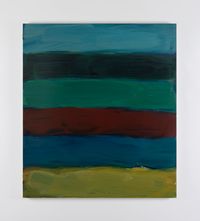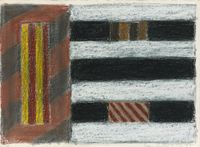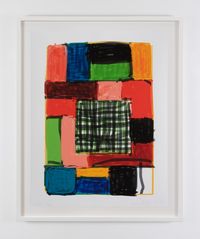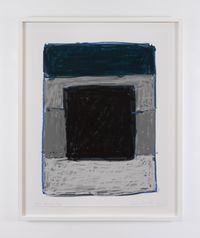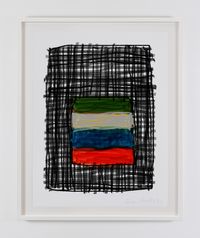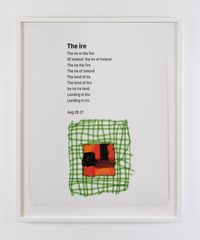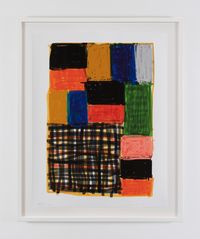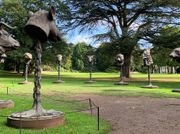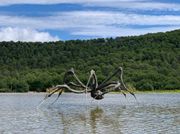Two-time Turner Prize nominee, artist Sean Scully has long been a proponent of abstraction. He is best known for his large-scale, grid-like paintings.
Read MoreDesiring to rescue abstraction from remoteness and re-inject it with exalted feeling. In a 2016 interview with Ocula Magazine, Scully explained 'in my paintings, I don't paint space. I paint things. I paint the stripe as if it's a kind of life and death.'
Born in Dublin, Sean Scully grew up south of London and studied painting at Croydon School of Art, London, and Newcastle University, where he was inspired by the colour field paintings of Mark Rothko and the minimalist abstraction of Bridget Riley. In the 1970s, he moved to America for a graduate fellowship at Harvard and later settled in New York, where he still lives part-time, in addition to Munich. His status as an immigrant and outsider has long been an important part of his philosophy about life and art.
Scully's earliest paintings, made in the UK, were inspired by the bright colours and wild stripes of Moroccan textiles. However, following his move to America in the 1970s, Scully simplified his motif and reigned in his palette.
Sean Scully's seminal paintings are characterised by compositions of rectangular or square sections painted in various colours—often deep, rich and stormy or autumn-toned hues. Thickly brushed layers of oil paint produce illusions of luminescence or movement, with a dynamic surface texture often compared to skin.
Reflecting his upbringing in working-class neighbourhoods and his adult life in cities, Scully's works from the 1980s were inspired by conflict, discord, haphazard urban planning and human competition for survival—weighty themes reflected in the paintings' sombre palettes and cramped, brick-like compositions. While in such early works Scully used tape to delineate the clean, structured sections on his canvases, he later abandoned that hard-edge aesthetic and began painting more loosely, allowing the shapes to breathe and show evidence of their making. In Battered Earth (1988), for example, patches of cream-coloured rectangles belie their earthy underlying layers, as do the blood-coloured sections with the umber paint beneath.
Showing a further loosening up of technique, Scully's major 'Wall of Light' series works (1998–ongoing) are first drawn out with charcoal stuck to the end of a long stick before being filled in with paint. The series begun when the artist was travelling in Mexico and was struck by the play of light on Mayan stone walls. Indeed, the combination of vertical and horizontal bars in Scully's paintings are often compared to architectural elements; the sections are said to resemble Stonehenge-like structures.
While he mostly works with oil on canvas, Scully also uses watercolour, pastels and aquatints, as well as painting directly on aluminium—a support that enhances the thickness of the oil paint and its illusion of emitting light.
Sean Scully's more recent sculptures borrow the same compositions as his paintings; Air (2018) is a large cube made of multi-coloured recinto, marble and cantera, assembled in blocks that create asymmetrical grid patterns when viewed from each angle.
Sean Scully has been named as a Turner Prize nominee twice: in 1989 and again in 1993. In 2o13 he was accepted into the Royal Academy of the Arts, London. He was also declared International Artist of the Year, by Harpers Bazaar Art, in 2016.
Sean Scully has been the subject of numerous solo exhibitions institutional and commercial exhibitions globally
Sean Scully solo exhibitions include: Sean Scully: Passenger – A Retrospective, Benaki Museum, Athens, Greece (2021); Sea Star: Sean Scully, National Gallery of Art, London (2019); Sean Scully: Resistance and Persistence. Paintings 1967-2015, Museum of the Nanjing University of the Arts, Nanjing (2016); Sean Scully: A Retrospective, Musée d'art Moderne, St. Etienne, France (2008); Sean Scully: Wall of Light, The Phillips Collection, Washington, DC (2005); Sean Scully on Paper, The Metropolitan Museum of Art, New York (2000); Sean Scully: Twenty Years, Hirshhorn Musuem and Sculpture Garden, Washington DC (1995); Sean Scully Paintings, 1975-1979, MoMA PS1, New York (1979).
Sean Scully group exhibtions include: Living with art: Picasso to Celmins, British Museum, London (2020); Beyond Borders, Villa Empain- Foundation Boghossian, Brussels (2018); Abstract Drawings, Smithsonian American Art Museum, Washington, D.C (2012); Homage to Chilida, Guggenheim Museum Bilbao (2006); A Century of Drawing: Works on Paper from Degas to LeWitt, National Gallery of Art, Washington, D.C (2001); Thinking Print: Books to Billboards 1980-95, Museum of Modern Art, New York (1996); After Matisse, Queens Museum, New York (1986); New Wave Painting, MoMA PS1, New York (1979).
Sean Scully's Instagram can be found here.
Michael Irwin | Ocula | 2022
